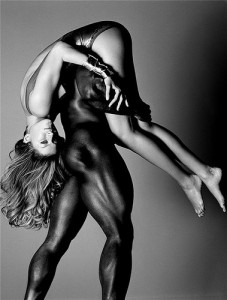Yeah, no (probably NSFW image below the fold):

Racialicious and Jezebel have the full photo spreads.
Putting aside the facts that Gisele and the dudes in the pictures are pretty smokin’ and that the photos are well done, I’ll just point out that the power dynamics the photos portray remind me of this notorious Vanity Fair cover with a clothed Tom Ford and a naked Kiera Knightly and Scarlett Johansson. When that came out, there was quite a bit of (righteous) feminist critique — because in Western culture, a clothed man surrounded by naked women sends a very particular message about sex and power.
Maybe my American racial baggage is informing my reaction to these photos, which were shot by a Norweigan photographer. Nonetheless, I can’t help seeing the black bodies used as props — faceless in the majority of cases — and as background to make Gisele stand out. Other commenters at Racialicious point to visual undercurrents of sexual assault and slavery.
What do you all think? (And I’ll add a caveat here that one can find images visually appealing and at the same time realize that they’re problematic, so let’s skip any quibbling over whether or not the photographs are “good” or “beautiful”).